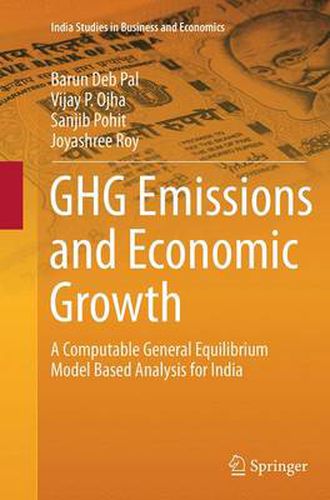Readings Newsletter
Become a Readings Member to make your shopping experience even easier.
Sign in or sign up for free!
You’re not far away from qualifying for FREE standard shipping within Australia
You’ve qualified for FREE standard shipping within Australia
The cart is loading…






This title is printed to order. This book may have been self-published. If so, we cannot guarantee the quality of the content. In the main most books will have gone through the editing process however some may not. We therefore suggest that you be aware of this before ordering this book. If in doubt check either the author or publisher’s details as we are unable to accept any returns unless they are faulty. Please contact us if you have any questions.
Issues linking climate change and economic growth are now at the centre of discussions regarding development strategies especially in the context of developing countries. This book contributes by analyzing the relationship between economic growth and GHG emissions in India with explicit reference to all major economic sectors. One of the most popular tools for macroeconomic policy analysis is Social Accounting Matrix (SAM). The book presents the methods and estimates of the latest Social Accounting Matrix (SAM) for India, which provides a major data base describing the complete circular flow of income and input-output transactions among the sectors of the economy. The novelty of the book lies in the fact that for the first time a SAM has been prepared for the Indian economy with environmental indicators. A detailed methodology for constructing such an extended SAM is also presented in the book. The environmental social accounting matrix (ESAM) based analysis has been included to show direct and indirect links between economic growth and GHG emissions. The book also includes analysis of factors affecting historical GHG emissions trends in India. The book goes beyond SAM and applies computable general equilibrium (CGE) modelling to derive climate-change policy analysis and simulations. This CGE-based analysis is an important contribution to the current debate surrounding carbon tax and its possible impact on macroeconomic growth.
$9.00 standard shipping within Australia
FREE standard shipping within Australia for orders over $100.00
Express & International shipping calculated at checkout
This title is printed to order. This book may have been self-published. If so, we cannot guarantee the quality of the content. In the main most books will have gone through the editing process however some may not. We therefore suggest that you be aware of this before ordering this book. If in doubt check either the author or publisher’s details as we are unable to accept any returns unless they are faulty. Please contact us if you have any questions.
Issues linking climate change and economic growth are now at the centre of discussions regarding development strategies especially in the context of developing countries. This book contributes by analyzing the relationship between economic growth and GHG emissions in India with explicit reference to all major economic sectors. One of the most popular tools for macroeconomic policy analysis is Social Accounting Matrix (SAM). The book presents the methods and estimates of the latest Social Accounting Matrix (SAM) for India, which provides a major data base describing the complete circular flow of income and input-output transactions among the sectors of the economy. The novelty of the book lies in the fact that for the first time a SAM has been prepared for the Indian economy with environmental indicators. A detailed methodology for constructing such an extended SAM is also presented in the book. The environmental social accounting matrix (ESAM) based analysis has been included to show direct and indirect links between economic growth and GHG emissions. The book also includes analysis of factors affecting historical GHG emissions trends in India. The book goes beyond SAM and applies computable general equilibrium (CGE) modelling to derive climate-change policy analysis and simulations. This CGE-based analysis is an important contribution to the current debate surrounding carbon tax and its possible impact on macroeconomic growth.